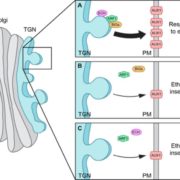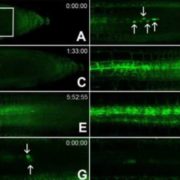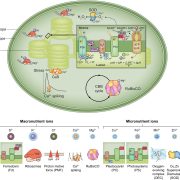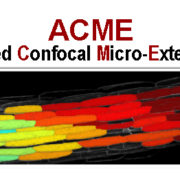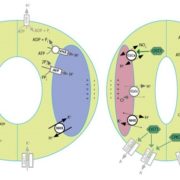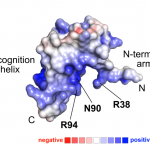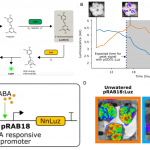A natural variant of ORANGE interacts with plastid division factor ARC3 to regulate chromoplast number and carotenoid accumulation (Mol. Plant)
 Some “superfoods” have high nutritional value due to the presence of carotenoids, which prevent degenerative diseases like cancer. In plants, these pigments are biosynthesized and stored by plastid organelles called chromoplasts. Chromoplast number and size define total carotenoid accumulation. ORHis, a natural allele of Orange (OR) in which a conserved Arg is replaced with a His, both promotes carotenoid accumulation in melon fruit, and decreases the number of chromoplasts per cell. Sun et al. investigated an ORHis variant of Arabidopsis OR and confirmed its effects as a chromoplast number regulator in addition to its functions in carotenoid biosynthesis and chromoplast biogenesis. The authors discovered that ORHis constrains chromoplast number by interacting with ARC3 (a central chloroplast division factor) and suppressing its interaction with PARC6 (another key regulator of chloroplast division). Additionally, the manipulation of the plastid division factors ARC3 and PDV1 significantly affected carotenoid levels in Arabidopsis ORHis calli, which provides a novel strategy for carotenoid enrichment in food crops. (Summary by Elisandra Pradella) Mol. Plant 10.1016/j.molp.2020.03.007
Some “superfoods” have high nutritional value due to the presence of carotenoids, which prevent degenerative diseases like cancer. In plants, these pigments are biosynthesized and stored by plastid organelles called chromoplasts. Chromoplast number and size define total carotenoid accumulation. ORHis, a natural allele of Orange (OR) in which a conserved Arg is replaced with a His, both promotes carotenoid accumulation in melon fruit, and decreases the number of chromoplasts per cell. Sun et al. investigated an ORHis variant of Arabidopsis OR and confirmed its effects as a chromoplast number regulator in addition to its functions in carotenoid biosynthesis and chromoplast biogenesis. The authors discovered that ORHis constrains chromoplast number by interacting with ARC3 (a central chloroplast division factor) and suppressing its interaction with PARC6 (another key regulator of chloroplast division). Additionally, the manipulation of the plastid division factors ARC3 and PDV1 significantly affected carotenoid levels in Arabidopsis ORHis calli, which provides a novel strategy for carotenoid enrichment in food crops. (Summary by Elisandra Pradella) Mol. Plant 10.1016/j.molp.2020.03.007
[altmetric doi=”10.1016/j.molp.2020.03.007″ details=”right” float=”right”]



